-
Engine7.0L V8
-
Power505 HP / 481 LB-FT
-
Transmission6-Speed Manual
-
0-60 Time4.0 Seconds (est.)
-
Top Speed170 MPH (est.)
-
DrivetrainRear-Wheel Drive
-
Curb Weight3,820 LBS
-
Seating2+2
-
Cargo11.3 CU-FT
-
MPGTBD
-
Base Price$75,000
Racecars are a completely different breed. These specialized machines are engineered with robustness to defeat the demons of racing. They boast braking systems capable of tolerating intense heat, dry-sump oil systems to provide crucial lubrication during cornering, and suspension calibrations to improve grip while promoting even tire wear. They are tuned for the rigors of speed and endurance.
The list of showroom-stock racecars is small and exclusive, but the fraternity has just added another member. It's called the 2014 Chevrolet Camaro Z/28.
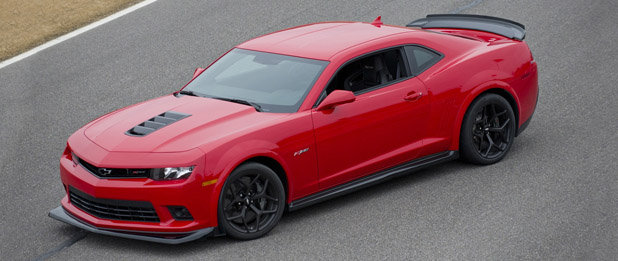
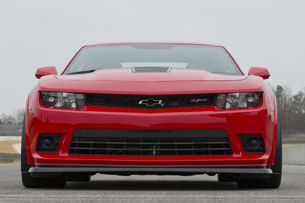
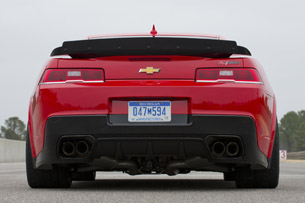
Today's fifth-generation Camaro has been around since 2010, and while it's been a great cruiser and a competent weekend drag car since Day One, the production car never really got serious about on-track performance until 2012, when Chevy introduced the $56,000 ZL1. The range-topping coupe packed a supercharged 6.2-liter LSA V8 rated at 580 horsepower and 556 pound-feet of torque. Accompanying the engine was a long list of upgrades including MagneRide suspension, six-piston calipers over two-piece iron rotors and 20-inch forged wheels with summer tires. The 4,118-pound coupe was a stoplight king with a good set of lungs (0-60 in 3.9 seconds with a top speed of 184 miles per hour). And while it was surprisingly, impressively competent on both public roads and racing circuits, its Achilles' heel remained its mass. In order to increase performance, everything had been upsized.
Chevrolet knew it could do better, so they assembled a capable team headed by GM engineer Mark Stielow, a car guy's best friend celebrated for building some of the best Pro Touring Camaro models on the planet. To build the most track-capable Camaro ever would require a herculean effort that would not only challenge conventional wisdom, it would involve some of the best names in automotive performance. According to Stielow, the team had one objective for the Z/28: "Make it as fast as it could go."The team had one objective for the Z/28: "Make it as fast as it could go."
Unveiled at the 2013 New York Auto Show, the $75,000 Camaro Z/28 stands as the fruit of their labor. As scrutinized on the turntable under the show's bright lights, the Z/28 boasts more than 190 unique components. Each has been carefully selected to optimize lap speeds around a roadcourse, meaning they are lightweight, highly functional and durable. And while each of its countless predecessors has been a street car tuned for track performance, the Z/28 is essentially a showroom stock racecar, one that's nearly 300 pounds lighter than the ZL1.
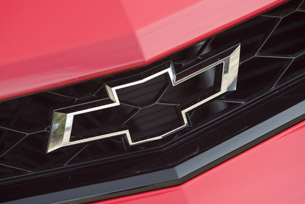
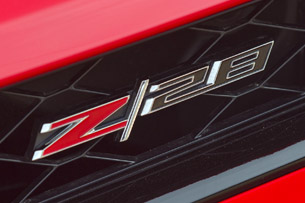

Ten months later and 862 miles southwest of New York's Javits Center, I found myself strapped into a Z/28 in the cold pits at Barber Motorsports Park not far from Birmingham, Alabama. As I secured the strap on my helmet and scanned the gauges, a gentleman from Chevy leaned in the open window and offered just one suggestion: radio into the pits when the fuel light illuminated.
Instead of a forced-induction powerplant, which adds weight, complexity and thermal management issues, the Z/28 engineering team has configured its coupe with a naturally aspirated 7.0-liter LS7 V8 fitted with titanium valves, Pankl titanium connecting rods and Mahle pistons. The proven engine is a variant of the powerplant found in the discontinued C6 Corvette Z06, carrying with it a rating of 505 horsepower and 481 pound-feet of torque. To provide consistent oil pressure during high-G cornering, the engine has been equipped with Camaro's first-ever dry sump lubrication. And to ensure proper cooling during track sessions, an integral liquid-to-liquid system has been added to keep synthetic oil temperatures low. The engine breathes through a K&N cold-air induction system with an oil-free paper cone air filter.Chevrolet has deliberately reduced the Z/28's acoustic insulation to reduce weight, and its absence grants open passage to the clamor of exploding fuel.
A quick turn of the key brings the 427-cubic-inch engine to life, noticeably shaking the entire chassis in the process. As expected, the free-breathing V8 idles with a deep, anxious growl. Chevrolet has deliberately reduced the Z/28's acoustic insulation to reduce weight, and its absence grants open passage to the clamor of exploding fuel, a rumble that permeates the walls of the firewall, floor and trunk. Even with a helmet on, there's enough auditory stimuli that I am already engrossed in the driving experience before leaving the pits.
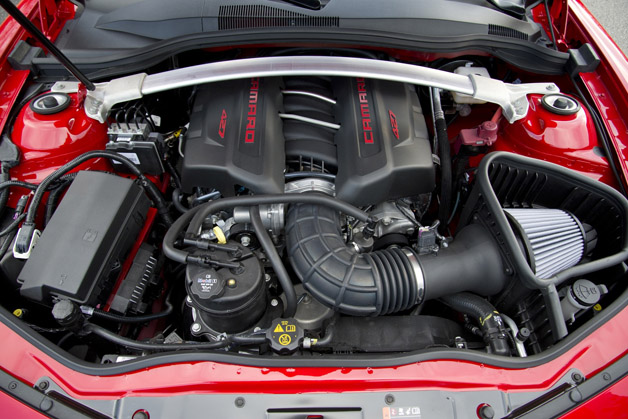
With ambient temperatures hovering about 10 degrees above freezing and the sky overhead a threateningly uniform gray, at least it was dry. The Z/28's standard leather-covered Recaro bucket seats, with their synthetic suede seating surfaces, offer cut-outs for shoulder harness, but traditional three-point belts remain standard, which I cinch tightly in preparation for track work. A glance around the cockpit reveals a deliberately spartan cabin that lacks a large infotainment screen, automatic climate controls or ventilated seat cushions in the interest of saving weight. Compared to the ZL1's cabin, this car's most obvious deletion is the absence of the four analog gauges below the manual HVAC controls – again, dropped to systematically reduce mass ("They were hard to see, anyway," Stielow confesses). Keen observers will also note that the tachometer's redline is marked at 7,000 rpm, a number significantly higher than on the Z/28's supercharged cousin.
In yet another a nod to enthusiasts, the Z/28 is only offered with a Tremec TR6060 six-speed manual, a transmission using close-ratio gearing and a 3.91:1 final drive ratio optimized for the LS7's power delivery. All gears have double- or triple cone synchronizers, each with friction surfaces designed to ease shifting. At the back end, a Torsen helical limited-slip differential ensures low coupling during corner entry, zero preload while mid-corner and rapid coupling during corner exit (traditional limited-slips, which lock the drive axle, are optimized for straight-line traction). Both the differential and transmission have been fitted with high-capacity liquid-to-liquid coolers for extreme duty.The Z/28's clutch reveals itself as ideally weighted despite the amount of work it has been tasked with.
Pulling out of the pits, the Z/28's clutch reveals itself as ideally weighted despite the amount of work it has been tasked with. Likewise, the short-throw manual gearbox feels very mechanical, yet still smooth and accurate in operation. There's no threat of an impending stall when pulling away from a standstill (there's too much rotating mass for that), but it's easy to break the cold tires free if you apply a bit too much throttle.
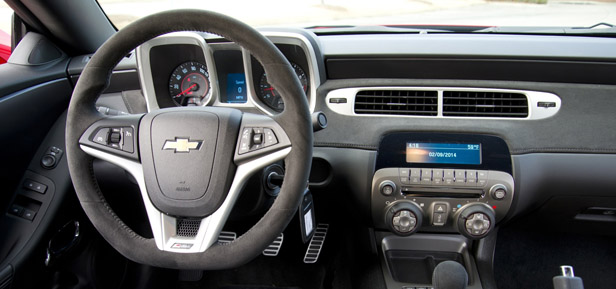
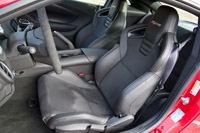
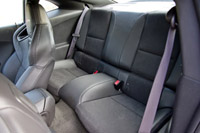
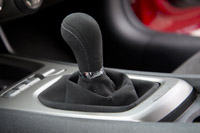
Heading onto the empty circuit, I'm able to systematically refresh my memory of Barber's 15 challenging turns while simultaneously putting some heat into the massive tires. It's interesting to note that the engineering team has tossed aside the ZL1's 20-inch wheel fitment in favor of slightly smaller forged 19-inch wheels. While they aren't as aesthetically pleasing when it comes to filling out the wheel wells, their reduced diameter offers a few benefits, including dropping the car's center of gravity by 1.3 inches and reducing unsprung weight to improve handling and acceleration. The Z/28 wears Pirelli Trofeo R tires at all four corners which have an R-compound treadwear rating of just 80. They are each sized 305/30ZR19, but the wheels on the rear axle are a half-inch wider, so they cannot be swapped front-to-back. (Their huge contact patches allows Chevrolet to boast that the Z/28 runs the widest front tire on any production car.)
After a handful of laps at parade speeds, the tire pressure monitor reads a few PSI higher at each corner – the tires are warming up. Time to put the red coupe to the test. According to Chevy, the Z/28 will do the benchmark 0-60 mph sprint in about four seconds, pull 1.05 Gs in flat cornering and brake with 1.5 Gs of deceleration. Each figure is exhilarating on its own, but taken as a whole, they help explain how the track star lapped Germany's legendary Nürburgring in a blistering 7:37, which is quicker than a Lexus LF-A.The Z/28 will do the benchmark 0-60 mph sprint in about four seconds, pull 1.05 Gs in flat cornering and brake with 1.5 Gs of deceleration.
Coming off Turn 15 onto the straight with the gearbox in third, I bury the accelerator. The quad exhaust pipes thunder with the sound and fury of a NASCAR Sprint Cup racer, pressing me firmly into the seat. Quickly approaching the first corner at over 100 mph, I lean hard on the brakes to convert kinetic energy into heat. The Z/28 uses drilled carbon-ceramic rotors (a Camaro first) in lieu of cast iron rotors, as the material is lighter and more tolerant to high temperatures. Oversized Brembo six- and four-piston alloy monobloc calipers clamp down on 15.5-inch rotors up front and 15.4-inch rotors in the rear, and the anti-lock brakes have even been reprogrammed to specifically accommodate late braking into corners and assist initial turn-in.
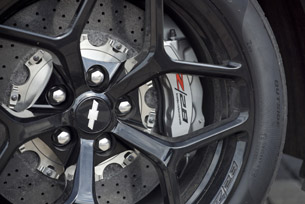
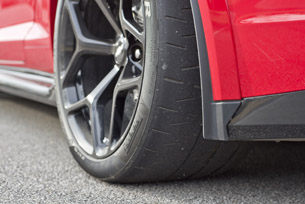
During testing, Chevy's engineers noted that the vehicle was braking so hard that the tires were slipping on their wheels. The solution? Media blasting their alloy surfaces to boost adhesion. So equipped, the carbon-ceramic brakes and footwear bite with a confidence normally only felt in supercars three times the price, allowing me to fly down Barber's front straight flat-out, lap after glorious lap. Never once would I need the runoff, but many times I found myself braking too early – a rarely earned compliment.
Although the Z/28's team had access to all of GM's suspension technology (including the ZL1's highly touted adaptive MagneRide system), they chose to go with a fixed-ratio damper setup by Multimatic. The custom spool-in-piston struts and dampers have been fitted with Dynamic Suspension Spool Valves (DSSV) that allowed the engineers to tune compression and rebound independently to suit the Camaro's track-focused mission. The balance of the componentry has also been modified, with 85 percent stiffer front springs, 65 percent stiffer rear springs and more rigid trailing-link, lower-arm links and upper control arm bushings to improve steering feel and handling stiffness.Body roll is negligible and the chassis doesn't noticeably pitch during hard acceleration or braking.
I'm a huge fan of BWI Group's magnetically controlled dampers, but Chevrolet's decision to go with a lighter Multimatic system on the Z/28 is a stroke of genius in terms of simplicity and reduced maintenance. The coupe rides very firmly, but bumps and impacts never feel harsh or abusive, body roll is negligible and the chassis doesn't noticeably pitch during hard acceleration or braking. Even when purposely hitting the track's kerbing at speed while clipping a corner, a jolt comes through the steering wheel, but the vehicle tracks through undisturbed. (I would later mention to the engineering team that the damping reminds me of the Porsche GT3, and they revealed that the much pricier German sports coupe was their exact benchmark.)
Overall stability has also been improved with the team's focus on aerodynamics. Yet instead of chasing low drag, they have focused on downforce. To that effect, the Z/28's nose wears a massive jutting lower splitter that forces air into the radiator and brake cooling ducts (it looks flimsy but can actually withstand 250 pounds of aerodynamic pressure). An open hood vent bleeds high-pressure air from the engine bay, and there are Gurney lip fender flares ahead of each front wheel. Lastly, a trunk-mounted adjustable rear spoiler keeps the back end planted. According to Chevrolet, the complete package produces 440 more pounds of downforce at 150 mph than the aero hardware on a standard Camaro SS. At speed, the two-door runs with an invisible heavy hand holding it down.The complete package produces 440 more pounds of downforce at 150 mph than the aero hardware on a standard Camaro SS.
The LS7 roars, barks and cackles as it thrusts the Z/28 around the racing circuit. From the driver's seat, there is little need to watch the thin orange needle of the tachometer sweep past the white numbers on the dial, as the sound and vibration of the engine makes it very clear as to when it's time to shift. Maximum torque hits at 4,800 rpm, with horsepower peaking at 6,100 rpm, but my internal gyroscopes tell me to shift at about 6,000 rpm – a number I can hit reliably without looking at the tach. Flicking the short-throw lever between third and fourth (and occasionally down to second) quickly becomes a second-nature operation that never results in a missed shift or grinding. I have no complaints about the Tremec TR6060.
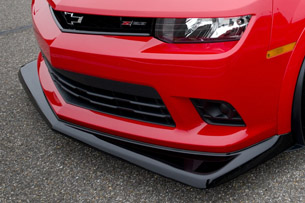
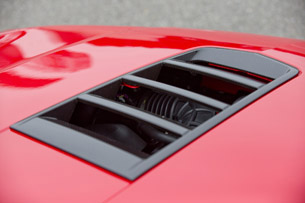
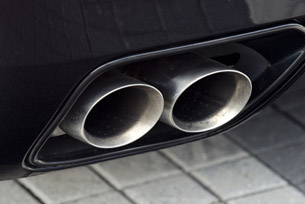
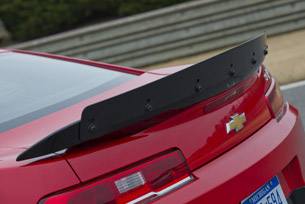
Over the years, I've driven on dozens of racetracks in over 100 different vehicles, and the impression each machine leaves is as unique as a fingerprint. The best quickly earn my confidence with an easily modulated throttle, a firm brake pedal and a stable, balanced platform in the corners. Others are lousy on a road circuit and I quickly toss back the keys.
It doesn't take but a half-dozen hot laps at Barber to realize that this Z/28 is the real deal – essentially a street-legal racecar. Despite the abuse of relentless full throttle, consistent ABS braking and high-g cornering, the engine oil would stay cool, the tires would wear perfectly level and nary a warning light dared illuminate on the dash. Only an empty fuel tank would bring me in.It doesn't take but a half-dozen hot laps at Barber to realize that this Z/28 is the real deal – essentially a street-legal racecar.
In addition to a full day on the track, I spent half-a-day tooling around on public roads. The Z/28's ride is understandably nowhere nearly as plush as the base 1LS, and the ZL1 feels comfortable in comparison (thanks to its MagneRide suspension), but I'd never call it punishing. The engine is very tractable around town, the steering feels great and the high performance brakes work well even when cold. The big concern, in terms of daily driving, are the R-compound tires that are noisy and lack grip at low temperatures (when they do heat up, their sticky tread clutches and then launches pebbles noisily into the wheel wheels). I suggest that owners invest in a second set of wheels, with more suitable rubber, for commuting.
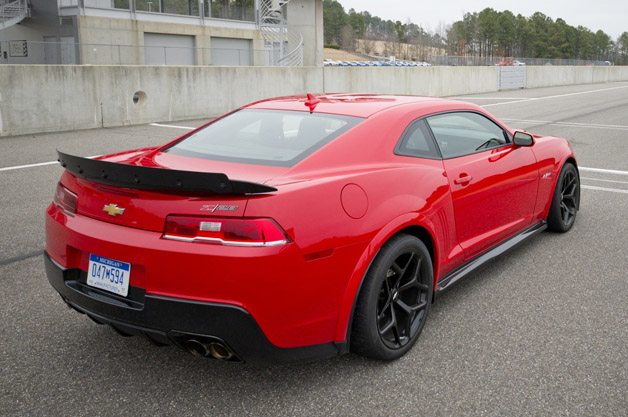
The coupe is nearly perfect on the racing circuit, but not perfectly flawless. My criticisms, if asked to lodge a few, focus on the thick A-pillar and exterior mirror which limit forward visibility when turning into the corners, the Recaro seats which don't hold my six-foot, two-inch frame as tightly as I would like, and the LS7's obvious appetite for premium unleaded ("Gasoline is yummy," Stielow proclaimed with a big grin). While those are all subjective grumbles, easily overlooked, I am sure others are actively questioning where the Z/28 fits in the big picture.
Considering its track-focused mission, Camaro Z/28 is an oddity in Chevrolet's lineup – and in the automotive marketplace, to be more accurate. Short of a Porsche GT3 or a Nissan GT-R Nismo, there are no other street-legal vehicle as track-focused currently for sale in the United States (and those mentioned are nearly twice the price). In terms of a direct competitor, one has to go back nearly 15 years to find the 2000 Ford SVT Mustang Cobra R, an equal departure from its mainstream siblings, to fully comprehend what the team at Chevrolet is presenting. The Ford was $55,845 at the time, a figure equally as astonishing to Mustang loyalists, but it was the ultimate performance variant designed for a select few – just like today's Z/28. In inflation-adjusted dollars, the Cobra R's price tag is almost exactly the same as this Camaro, yet the Z/28 is more capable (Ford offers nothing as track proficient today)."Nobody asked me to make it cheap; they asked me to make it fast."
At more than $75,000, Chevrolet's new track star certainly isn't cheap, but I would argue that it's a bargain – especially when people acknowledge that some of the world's greatest supercars (at any price) aren't as adept on a road course. When I asked Mark Stielow about the Z/28's jaw-dropping sticker price, his reply was far from apologetic."Nobody asked me to make it cheap; they asked me to make it fast." After a day on the racetrack with the Camaro Z/28, it's obvious that he and his team have accomplished that goal – exceptionally well.
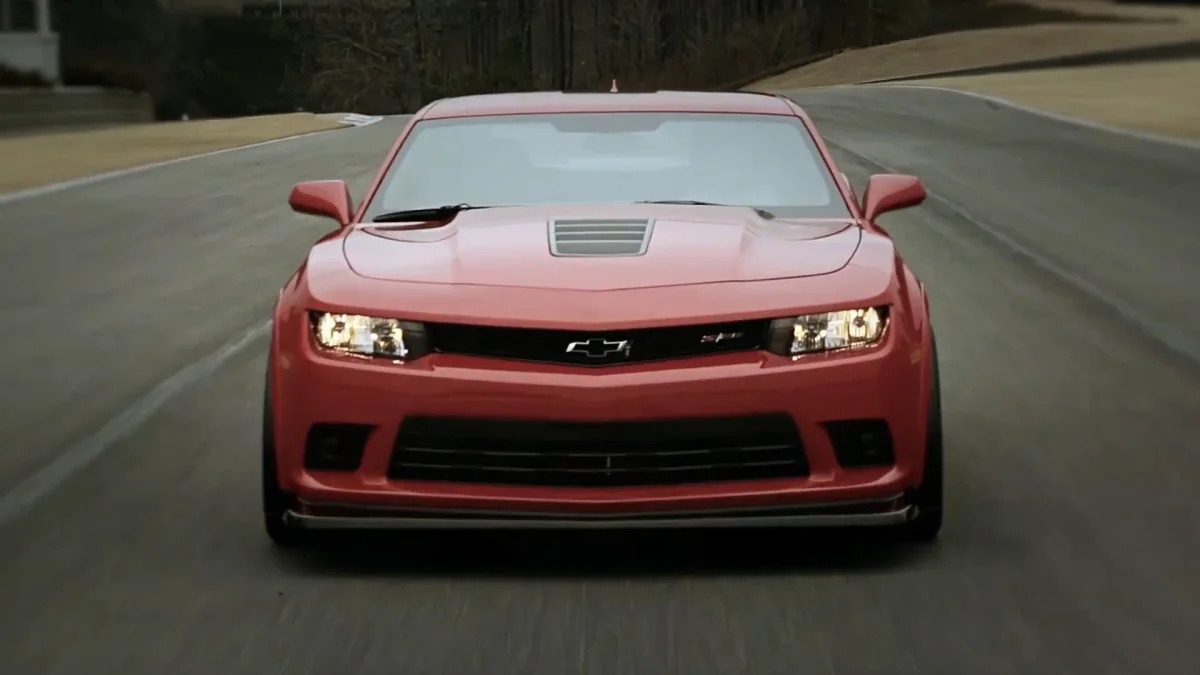









Sign in to post
Please sign in to leave a comment.
Continue